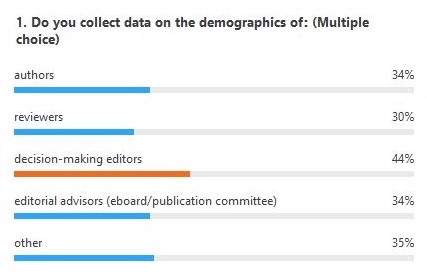MODERATOR:
Christine Laine
Editor-in-Chief, Annals of Internal Medicine
Philadelphia, Pennsylvania
REPORTER:
Erin Landis
Vice President of Publications
American Gastroenterological Association
Bethesda, Maryland
The “Editors-in-Chief Roundtable: DEI and the EIC” session of CSE’s 2021 Annual Meeting provided an opportunity for editors-in-chief (EIC) and editorial staff to discuss what efforts they have undertaken, or are considering, to address issues of diversity, equity, and inclusion (DEI) within their journals’ content, editorial boards, practices, policies, and procedures. The session underscored how such initiatives are imperative to the progress of improving the diversity, equity, and inclusiveness of the scientific publishing process and community.
Dr Christine Laine opened the session by conducting a brief poll, inquiring how many of the journals present in the meeting collect demographic information of various stakeholders in the scientific publishing process. For most stakeholder types, only about a third of the journals collect such information (Figure 1).

Dr Laine pointed out that collecting demographic information from authors and reviewers can be challenging. If the journal does so only for accepted articles or for reviewers who complete reviews, you have an incomplete picture. There are also different opinions about whether information on author demographics should be available to decision-making editors during peer review. The EIC of Science stated that they collect demographic data at the time of submission but that such data is only available to editorial staff (not editors or reviewers). Dr Laine followed the first poll with a second question: “Do you have a DEI editor?” Only 13% stated “yes” (Figure 2).

Dr May R Berenbaum, EIC of PNAS, shared her journal’s experience with DEI efforts. She stated that PNAS chose to first address the lack of diversity on their editorial board. They focused on issues such as geographical location, public vs. private institutions, and coastal vs. middle-of-the-U.S. institutions, noting that these demographics were somewhat easier to address than racial and ethic diversity, although they’ve been able to make gains in this area as well. She noted that the pool of researchers to draw from for the editorial board also is insufficiently diverse.
Several EICs also remarked how it is challenging to collect data from authors outside of the U.S., as asking such questions may be seen as irrelevant, offensive, or invasive. Additionally, those outside the U.S. may not be familiar with the terminology we use when collecting demographic information. One way to mitigate these concerns is to ensure that journals state 1) why they are collecting the data; 2) how they will use it; and 3) how it will be stored.
What key demographics should a journal consider collecting? The EICs in the session put forth list for consideration:
- Gender
- Race/ethnicity
- Geographic location
- Age
- Disabilities
- Veteran status
- Public vs. private institutions
- Academic vs. industry
- Career stage
- Sexual orientation
A short discussion around issues of unconscious bias focused on the double-blind peer review model and its possible role in reducing bias. However, many noted that this model can be challenged by preprints and the ability of editors and reviewers to correctly “guess” who authored an article. Often, blinding information within the actual manuscript, not just the byline, is needed to achieve adequate blinding.
The last portion of the session focused on the role of DEI editors: What are their specific directives? For some journals, these editors write and review content, oversee new initiatives and programs, and serve as advisors. For other journals, DEI editors evaluate current policies and procedures through a DEI lens and make suggestions for improvement.
